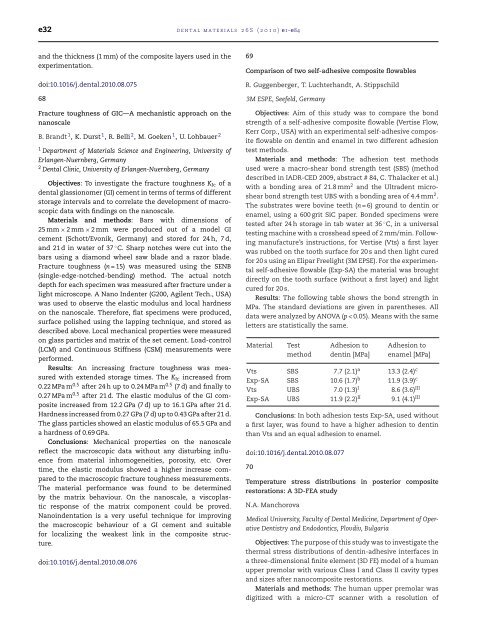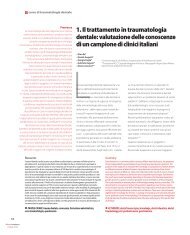Abstracts of the Academy of Dental Materials Annual ... - IsiRed
Abstracts of the Academy of Dental Materials Annual ... - IsiRed
Abstracts of the Academy of Dental Materials Annual ... - IsiRed
You also want an ePaper? Increase the reach of your titles
YUMPU automatically turns print PDFs into web optimized ePapers that Google loves.
e32 dental materials 26S (2010) e1–e84<br />
and <strong>the</strong> thickness (1 mm) <strong>of</strong> <strong>the</strong> composite layers used in <strong>the</strong><br />
experimentation.<br />
doi:10.1016/j.dental.2010.08.075<br />
68<br />
Fracture toughness <strong>of</strong> GIC—A mechanistic approach on <strong>the</strong><br />
nanoscale<br />
B. Brandt 1 , K. Durst 1 , R. Belli 2 , M. Goeken 1 , U. Lohbauer 2<br />
1 Department <strong>of</strong> <strong>Materials</strong> Science and Engineering, University <strong>of</strong><br />
Erlangen-Nuernberg, Germany<br />
2 <strong>Dental</strong> Clinic, University <strong>of</strong> Erlangen-Nuernberg, Germany<br />
Objectives: To investigate <strong>the</strong> fracture toughness KIc <strong>of</strong> a<br />
dental glassionomer (GI) cement in terms <strong>of</strong> terms <strong>of</strong> different<br />
storage intervals and to correlate <strong>the</strong> development <strong>of</strong> macroscopic<br />
data with findings on <strong>the</strong> nanoscale.<br />
<strong>Materials</strong> and methods: Bars with dimensions <strong>of</strong><br />
25 mm × 2mm× 2 mm were produced out <strong>of</strong> a model GI<br />
cement (Schott/Evonik, Germany) and stored for 24 h, 7 d,<br />
and 21 d in water <strong>of</strong> 37 ◦ C. Sharp notches were cut into <strong>the</strong><br />
bars using a diamond wheel saw blade and a razor blade.<br />
Fracture toughness (n = 15) was measured using <strong>the</strong> SENB<br />
(single-edge-notched-bending) method. The actual notch<br />
depth for each specimen was measured after fracture under a<br />
light microscope. A Nano Indenter (G200, Agilent Tech., USA)<br />
was used to observe <strong>the</strong> elastic modulus and local hardness<br />
on <strong>the</strong> nanoscale. Therefore, flat specimens were produced,<br />
surface polished using <strong>the</strong> lapping technique, and stored as<br />
described above. Local mechanical properties were measured<br />
on glass particles and matrix <strong>of</strong> <strong>the</strong> set cement. Load-control<br />
(LCM) and Continuous Stiffness (CSM) measurements were<br />
performed.<br />
Results: An increasing fracture toughness was measured<br />
with extended storage times. The KIc increased from<br />
0.22 MPa m 0.5 after 24 h up to 0.24 MPa m 0.5 (7 d) and finally to<br />
0.27 MPa m 0.5 after 21 d. The elastic modulus <strong>of</strong> <strong>the</strong> GI composite<br />
increased from 12.2 GPa (7 d) up to 16.1 GPa after 21 d.<br />
Hardness increased from 0.27 GPa (7 d) up to 0.43 GPa after 21 d.<br />
The glass particles showed an elastic modulus <strong>of</strong> 65.5 GPa and<br />
a hardness <strong>of</strong> 0.69 GPa.<br />
Conclusions: Mechanical properties on <strong>the</strong> nanoscale<br />
reflect <strong>the</strong> macroscopic data without any disturbing influence<br />
from material inhomogeneities, porosity, etc. Over<br />
time, <strong>the</strong> elastic modulus showed a higher increase compared<br />
to <strong>the</strong> macroscopic fracture toughness measurements.<br />
The material performance was found to be determined<br />
by <strong>the</strong> matrix behaviour. On <strong>the</strong> nanoscale, a viscoplastic<br />
response <strong>of</strong> <strong>the</strong> matrix component could be proved.<br />
Nanoindentation is a very useful technique for improving<br />
<strong>the</strong> macroscopic behaviour <strong>of</strong> a GI cement and suitable<br />
for localizing <strong>the</strong> weakest link in <strong>the</strong> composite structure.<br />
doi:10.1016/j.dental.2010.08.076<br />
69<br />
Comparison <strong>of</strong> two self-adhesive composite flowables<br />
R. Guggenberger, T. Luchterhandt, A. Stippschild<br />
3M ESPE, Seefeld, Germany<br />
Objectives: Aim <strong>of</strong> this study was to compare <strong>the</strong> bond<br />
strength <strong>of</strong> a self-adhesive composite flowable (Vertise Flow,<br />
Kerr Corp., USA) with an experimental self-adhesive composite<br />
flowable on dentin and enamel in two different adhesion<br />
test methods.<br />
<strong>Materials</strong> and methods: The adhesion test methods<br />
used were a macro-shear bond strength test (SBS) (method<br />
described in IADR-CED 2009, abstract # 84, C. Thalacker et al.)<br />
with a bonding area <strong>of</strong> 21.8 mm 2 and <strong>the</strong> Ultradent microshear<br />
bond strength test UBS with a bonding area <strong>of</strong> 4.4 mm 2 .<br />
The substrates were bovine teeth (n = 6) ground to dentin or<br />
enamel, using a 600 grit SiC paper. Bonded specimens were<br />
tested after 24 h storage in tab water at 36 ◦ C, in a universal<br />
testing machine with a crosshead speed <strong>of</strong> 2 mm/min. Following<br />
manufacture’s instructions, for Vertise (Vts) a first layer<br />
was rubbed on <strong>the</strong> tooth surface for 20 s and <strong>the</strong>n light cured<br />
for 20 s using an Elipar Freelight (3M EPSE). For <strong>the</strong> experimental<br />
self-adhesive flowable (Exp-SA) <strong>the</strong> material was brought<br />
directly on <strong>the</strong> tooth surface (without a first layer) and light<br />
cured for 20 s.<br />
Results: The following table shows <strong>the</strong> bond strength in<br />
MPa. The standard deviations are given in paren<strong>the</strong>ses. All<br />
data were analyzed by ANOVA (p < 0.05). Means with <strong>the</strong> same<br />
letters are statistically <strong>the</strong> same.<br />
Material Test<br />
method<br />
Adhesion to<br />
dentin [MPa]<br />
Adhesion to<br />
enamel [MPa]<br />
Vts SBS 7.7 (2.1) a 13.3 (2.4) c<br />
Exp-SA SBS 10.6 (1.7) b 11.9 (3.9) c<br />
Vts UBS 7.0 (1.3) I 8.6 (3.6) III<br />
Exp-SA UBS 11.9 (2.2) II 9.1 (4.1) III<br />
Conclusions: In both adhesion tests Exp-SA, used without<br />
a first layer, was found to have a higher adhesion to dentin<br />
than Vts and an equal adhesion to enamel.<br />
doi:10.1016/j.dental.2010.08.077<br />
70<br />
Temperature stress distributions in posterior composite<br />
restorations: A 3D-FEA study<br />
N.A. Manchorova<br />
Medical University, Faculty <strong>of</strong> <strong>Dental</strong> Medicine, Department <strong>of</strong> Operative<br />
Dentistry and Endodontics, Plovdiv, Bulgaria<br />
Objectives: The purpose <strong>of</strong> this study was to investigate <strong>the</strong><br />
<strong>the</strong>rmal stress distributions <strong>of</strong> dentin-adhesive interfaces in<br />
a three-dimensional finite element (3D FE) model <strong>of</strong> a human<br />
upper premolar with various Class I and Class II cavity types<br />
and sizes after nanocomposite restorations.<br />
<strong>Materials</strong> and methods: The human upper premolar was<br />
digitized with a micro-CT scanner with a resolution <strong>of</strong>



